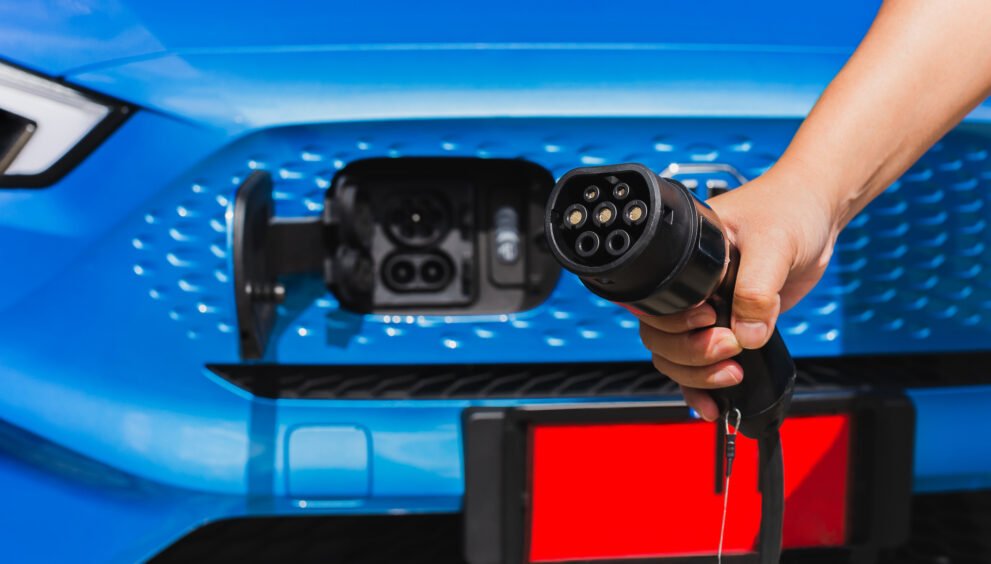Do Electric Cars Have Exhaust? Your Guide to EV Emissions

As you consider switching to an electric vehicle (EV), you might be wondering about the emissions associated with these cars. The question on many minds is, “Do electric cars have exhaust?” Understanding the emissions from electric vehicles is crucial in making an informed decision about your next car.

Electric vehicles are gaining popularity, and it’s essential to explore how they differ from traditional combustion engine vehicles in terms of emissions. This guide will provide a comprehensive overview of EV emissions, helping you understand the environmental impact of electric cars.
Key Takeaways
- Understanding the emissions associated with electric vehicles.
- How electric vehicles differ from traditional combustion engine vehicles.
- The environmental impact of electric cars.
- What to expect from an electric vehicle’s emissions.
- The benefits of switching to an electric vehicle.
Do Electric Cars Have Exhaust Systems?
The absence of exhaust systems in electric cars becomes clear when we explore how traditional combustion engines work and how electric vehicles (EVs) differ. Traditional combustion engines, found in most gasoline or diesel-powered vehicles, rely on burning fuel to generate power.
How Traditional Combustion Engines Work
In a traditional combustion engine, air and fuel are mixed and ignited inside the engine’s cylinders, producing a small explosion that drives the piston down. This process is repeated multiple times per minute, generating the power needed to propel the vehicle forward. However, this combustion process also produces exhaust gases, including carbon dioxide (CO2), nitrogen oxides (NOx), and particulate matter, which are released into the atmosphere through the exhaust system.
The exhaust system in traditional vehicles is designed to manage these emissions, including a catalytic converter to reduce harmful pollutants and a muffler to minimize noise. Despite these efforts, combustion engines remain a significant source of air pollution.
The Fundamental Difference in EV Design

Electric vehicles, on the other hand, are powered by electric motors and batteries. The electric motor uses electrical energy stored in the battery to generate power, eliminating the need for combustion and, consequently, the exhaust system. This fundamental difference in design means that electric cars do not produce tailpipe emissions, significantly reducing their environmental impact.
- Electric cars are powered by batteries and electric motors.
- They do not burn fuel, so they do not produce exhaust gases.
- The absence of an exhaust system simplifies the vehicle’s design and reduces maintenance needs.
As noted by environmental experts, “Electric vehicles represent a significant step towards reducing urban air pollution and mitigating climate change.” This shift towards electric vehicles is part of a broader effort to create more sustainable transportation solutions.
“The future of transportation is electric, and it’s happening now. With electric vehicles, we’re not just reducing emissions; we’re redefining the way we think about mobility.”
— Elon Musk, CEO of Tesla
In summary, electric cars do not have exhaust systems because they are powered by electric motors and batteries, not by combustion engines. This design difference is crucial for reducing emissions from electric cars and making them a more environmentally friendly option.
How Electric Vehicles Generate and Release Energy
Understanding how electric vehicles generate and release energy is crucial for appreciating their efficiency and environmental benefits. You might be wondering how electric cars manage to operate without the traditional combustion engine. The answer lies in their battery-powered design.
Electric vehicles (EVs) generate energy through advanced battery systems, a stark contrast to the fuel combustion process in traditional vehicles. This fundamental difference significantly impacts how EVs release energy and manage heat, directly addressing concerns about electric car pollution and electric vehicle tailpipe emissions. Since electric cars do not burn fuel, they do not produce tailpipe emissions, making them an attractive option for those concerned about air quality.
Battery Power vs. Fuel Combustion
The core difference between EVs and traditional vehicles is their power source. EVs are powered by rechargeable battery packs, typically made from lithium-ion cells. These batteries store electrical energy that is used to propel the vehicle. In contrast, traditional vehicles rely on the combustion of fossil fuels to generate power.
The battery power system in EVs offers several advantages, including higher efficiency and lower operating costs. EVs convert about 60% to 70% of the electrical energy from the grid to power the wheels, while conventional gasoline vehicles only convert about 20% of the energy stored in gasoline to power the wheels.
Heat Management in Electric Cars
Heat management is a critical aspect of EV operation. While EVs do not produce tailpipe emissions, they still generate heat, primarily from their battery systems and electric motors. Effective heat management is essential for maintaining the performance, efficiency, and longevity of EVs.
Most EVs employ sophisticated cooling systems to manage heat. These systems can be air-based or liquid-based, designed to keep the battery and other components within optimal temperature ranges. By managing heat effectively, EVs can maintain their performance and range, even under demanding driving conditions.
As you consider the benefits of electric vehicles, it’s clear that their energy generation and release mechanisms play a crucial role in their overall efficiency and environmental impact. With zero tailpipe emissions and advanced heat management systems, EVs represent a significant step forward in reducing electric car pollution.
The Real Environmental Impact of Electric Cars
While electric vehicles produce zero tailpipe emissions, their total environmental footprint is influenced by several factors. To understand their overall impact, it’s essential to consider both the direct and indirect emissions associated with EVs.
Direct vs. Indirect Emissions
Direct emissions refer to the pollutants released directly from the vehicle. In the case of electric cars, there are zero tailpipe emissions, making them an attractive option for reducing air pollution in urban areas. However, indirect emissions, which include the production of electricity used to charge EVs, can vary significantly depending on the energy mix of the grid supplying the electricity.
Key consideration: The environmental benefits of EVs are maximized when the electricity used to charge them comes from renewable sources.
Electricity Generation Sources
The source of electricity used to charge electric vehicles plays a crucial role in determining their overall environmental impact. In regions where the grid is predominantly powered by renewable energy sources like solar or wind, the carbon footprint of EVs is significantly lower compared to areas reliant on fossil fuels.

Common Misconceptions About EV Pollution
There’s a common misconception that electric vehicles are completely emission-free. While they produce no tailpipe emissions, the production process, particularly battery manufacturing, has its own environmental costs.
Manufacturing Emissions
The production of electric vehicles, especially their batteries, generates emissions. Studies have shown that the manufacturing phase of EVs typically produces more emissions than that of conventional vehicles. However, this is often offset by the lower operational emissions over the vehicle’s lifetime.
Battery Production and Disposal
Battery production is a significant contributor to the upfront emissions of EVs. Nevertheless, advancements in battery technology and recycling methods are continually reducing this impact. Moreover, many manufacturers are now designing batteries with recyclability in mind, further mitigating their environmental footprint.
It’s crucial to consider the entire lifecycle of electric vehicles when assessing their environmental impact.
By understanding the complexities of EV emissions, from production to operation, you can make more informed decisions about your transportation choices and their environmental implications.
The Future of Zero-Emission Transportation

As you explore the world of electric vehicles (EVs), it’s clear that they’re leading the charge towards zero-emission transportation. Since electric cars don’t produce exhaust gases, they’re a crucial part of a broader movement to reduce emissions across all sectors. The future of EVs looks promising, with ongoing developments in EV technology and infrastructure paving the way for a more sustainable transportation system.
You can expect significant advancements in battery technology, expanding charging networks, and increased adoption of EVs by major automakers like Tesla and General Motors. As the grid becomes increasingly powered by renewable energy sources, the overall environmental benefits of EVs will continue to grow, reducing electric vehicle exhaust gases associated with electricity generation.
By embracing EVs, you’re not only reducing your carbon footprint but also driving demand for cleaner energy solutions. The shift towards zero-emission transportation is gaining momentum, and as it continues to evolve, you can look forward to a cleaner, healthier environment for future generations.
FAQ
Do electric cars have exhaust systems like traditional combustion engine vehicles?
No, electric cars do not have exhaust systems. They are powered by electric motors and batteries, eliminating the need for a traditional exhaust system.
How do electric vehicles generate energy?
Electric vehicles generate energy through battery power, using electricity from their batteries to propel the vehicle, unlike traditional vehicles that burn fuel.
What about electric car pollution?
Electric cars produce zero tailpipe emissions, reducing air pollution in urban areas. However, their overall environmental impact depends on the sources of electricity used to charge them.
Are electric vehicle emissions comparable to traditional vehicles?
Electric vehicles generally have lower overall emissions than traditional combustion engine vehicles, especially as the grid becomes increasingly powered by renewable energy sources.
What are the emissions associated with manufacturing electric cars?
The production of electric vehicles, particularly battery production, generates emissions. However, studies show that EVs typically offset these emissions through their zero tailpipe emissions during operation.
How do electricity generation sources impact electric vehicle emissions?
The environmental impact of EVs is influenced by the sources of electricity used to charge them. Renewable energy sources like solar and wind reduce the overall emissions associated with EVs.
Do electric cars have tailpipe emissions?
No, electric cars do not produce tailpipe emissions because they are powered by electricity and do not burn fuel.
What is the environmental impact of electric vehicle battery disposal?
The disposal of EV batteries is being addressed through recycling and repurposing. As the industry evolves, more sustainable practices for battery disposal are being developed.
How do electric cars compare to traditional vehicles in terms of emissions?
Electric cars generally offer a more environmentally friendly alternative to traditional combustion engine vehicles, with lower overall emissions, especially in regions with clean energy grids.
































































































































































































